Use of Hydrogen in Off-Grid Locations, a Techno-Economic Assessment
Abstract
:1. Introduction
- Only electrical application
- Two locations with different amount of solar resource: Tenerife (Spain) with high potential and Edinburgh (Scotland) with low potential.
2. Materials and Methods
2.1. Simulation Tool
- The possibility to integrate different degrees of technical modeling of the different system components (production units, storage units, power converters, auxiliary components).
- The possibility to represent ageing of a given component through different approaches.
- A high level of modularity to represent different architectures of electrical and fluidic systems (choice of AC or DC buses, location of power converters).
- The ability to run simulations on small time steps in order to fully consider the impacts of intermittency and limited predictability of renewable energy sources on the economic results. Typical time steps range between 1 s and 1 h.
- The possibility to systematically optimize both the system sizing and the power control strategy.
2.2. Case Study Presentation
2.2.1. Business Case Boundaries
- 1 kW steady load: representing a fixed load over the whole year illustrating power demand from a telecom antenna. This load, representing a total of 8.76 MWh over the year, is evaluated both in Tenerife and Edinburgh.
- 4 kW steady load: representing a fixed load over the whole year, illustrating power demand from a telecom antenna. This load, representing a total of 35.04 MWh over the year, is evaluated both in Tenerife and Edinburgh.
- Home load in Tenerife including lights, home equipment, air conditioning, and heating is not included.
- Home load in Edinburgh with the same scope as in Tenerife.
2.2.2. Ely4off Configuration
2.2.3. Power Systems in Competition
- Photovoltaic (PV)–battery (BAT): two different technologies of batteries are considered—Lead-Acid (Pb-a) and Li-Ion.
- PV-Diesel generator: the diesel generator is used as a back-up when PV power is not sufficient.
- Diesel generator only.
2.2.4. Techno-Economic Hypothesis
2.2.5. Optimization Criteria and Methodology
- Technical criterion: unsatisfied electrical load. The results presented in this paper are all considering 100% satisfaction of the load, because the load must be supplied 24/7. The equation is based on the difference between the provided load and the total required.
- Economic criterion: levelized cost of energy (LCOE). It can be defined as the total cost required to install, operate, and maintain a power-generating asset over its lifetime, divided by the total energy output of the asset over that lifetime. Equation is defined in [22].where n—life of the system, d—discount rate, y—year
2.3. Sensitivity Analysis
3. Simulation Results
Results
- Steady load 1 kW in Tenerife
- Steady load 4 kW in Tenerife
- Variable load (home) in Tenerife
- Steady load 1 kW in Edinburgh
- Steady load 4 kW in Edinburgh
- Variable load (home) in Edinburgh
4. Discussion
- LCOE for PV-Bat and PV-Bat-H2 observed in Tenerife are three times lower than those observed in Edinburgh. This is not surprising, but the results offer a quantitative tool worthy for assessing the implementation of these technologies in locations with different solar resources.
- The elements that appear to be giving hydrogen an advantage are:
- ⚬
- A high seasonality for PV production requiring a large quantity of energy stored in summer to be reused in winter, as is shown for Edinburgh in Figure 8. In all of the scenarios assessed for Tenerife, the most expensive technology is PV-Bat-H2, while in Edinburgh, PV-Bat-H2 is the third-best technology in two scenarios.
- ⚬
- It powers a demanding profile requiring daily energy shift from day to night.
- ⚬
- A constrained PV production due to limited available surface.
- For PV-Bat-H2, in scenarios where hydrogen seems to have a potential interest compared with the rest of the competitors (steady loads in Edinburgh), a conclusion is that when a PV surface available is limited, increasing the electrolysis size may present a techno-economic interest.
- Diesel-based systems still allow lower costs than any other solution, even if we consider 3 €/L fuel cost, after the sensitivity analysis performed for different values of fuel cost as defined in the economic hypothesis.
Comparison with Other Studies
- To begin with, it is common to use the software HOMER to obtain LCOE values in these off-grid scenarios; however, this software has an important limitation of editable parameters when hydrogen is part of the system [10,23]. The use of ODYSSEY allows the modeling and programming of an infinite number of flows of mass, energy, etc. Elements such as the electrolyzer are modeled to include complex parameters, such as stoichiometry, pressure, operation temperature, and polynomial efficiency. This is reflected in the results and strategies to follow.
- Some economic and technical data from Table 2 and Table 3 are part of the current knowledge of the different project partners. Some values come from a specialized company in the manufacturing of integrated hydrogen energy systems (ITM Power) and from an innovative converter manufacturing company (Epic Power). Their business experience and market knowledge has a great impact over the main assumptions.
- The Ely4off object of this assessment is a novel system, which allows total independence of the grid, even in very cold locations where anti-freezing action is needed. It also guarantees that the essential load is covered and allows direct coupling of the photovoltaic source to the PEM electrolyzer, avoiding losses. Other assessments based on renewable hydrogen for re-electrification do not consider a 100% of renewable penetration [24].
- This paper presents the use of hydrogen-based power to power systems and is compared against their main competitors that are common current solutions. This allows a wide outlook of the current status in off-grid scenarios, not only the ones based on hydrogen, but also on batteries and diesel generators.
- Other approaches consider alkaline technologies and larger systems (>1 MW) [25]. The values obtained here are for different purposes and the use of PEM technology is more suitable to the variability of the renewable sources than alkaline, thanks to its dynamic operation, as shown in previous studies [26].
5. Conclusions
Author Contributions
Funding
Acknowledgments
Conflicts of Interest
References
- Shonali, P.; Abeeku, B.-H.; Douglas, F.B.; Daniel, H.B.; Stephen, G. Chapter 19: Energy Access for Development. In Global Energy Assessment—Toward a Sustainable Future; Cambridge University Press: Cambridge, UK, 2012; ISBN 978-1-107-00519-8. [Google Scholar]
- Ferroikhi, R.; Lucas, H.; Renner, M.; Lehr, U.; Breitschopf, B.; Lallement, D. IRENA. Renewable Energy and Jobs; International Renewable Energy Agency: Abu Dhabi, Vereinigte Arabische Emirate, 2013; p. 144. [Google Scholar]
- Gielen, D.; Gorini, R.; Wagner, N.; Leme, R.; Gutierrez, L.; Prakash, G. Global Energy Transformation: A Roadmap to 2050; International Renewable Energy Agency: Abu Dhabi, Vereinigte Arabische Emirate, 2018; p. 76. [Google Scholar]
- Kempener, R.; Lavagne d’Ortigue, O.; Saygin, D.; Skeer, J.; Vinci, S.; Gielen, D. Off-grid renewable energy systems: Status and methodological issues. Int. Renew. Energy Agency Abu Dhabi 2015, 36. [Google Scholar]
- Commission, E. A Roadmap for moving to a competitive low carbon economy in 2050. COM 2011, 112, 16. [Google Scholar]
- IRENA Hydrogen from renewable power: Technology outlook for the energy transition. Int. Renew. Energy Agency Abu Dabhi 2018, 52.
- Chardonnet, C.; Giordano, V.; De Vos, L.; Bart, F.; De Lacroix, T. Study on Early Business Cases For H2 in Energy Storage and More Broadly Power to H2 Applications; FCH-JU: Brussels, Belgium, 2017; p. 228. [Google Scholar]
- Bielmann, M.; Vogt, U.F.; Zimmermann, M.; Züttel, A. Seasonal energy storage system based on hydrogen for self sufficient living. J. Power Sourc. 2011, 196, 4054–4060. [Google Scholar] [CrossRef]
- Scamman, D.; Newborough, M.; Bustamante, H. Hybrid hydrogen-battery systems for renewable off-grid telecom power. Int. J. Hydrog. Energy 2015, 40. [Google Scholar] [CrossRef]
- Singh, A.; Baredar, P.; Gupta, B. Techno-economic feasibility analysis of hydrogen fuel cell and solar photovoltaic hybrid renewable energy system for academic research building. Energy Convers. Manag. 2017, 145, 398–414. [Google Scholar] [CrossRef]
- Bruni, G.; Cordiner, S.; Mulone, V.; Giordani, A.; Savino, M.; Tomarchio, G.; Malkow, T.; Tsotridis, G.; Bodker, S.; Jensen, J.; et al. Fuel cell based power systems to supply power to Telecom Stations. Int. J. Hydrog. Energy 2014, 39, 21767–21777. [Google Scholar] [CrossRef]
- Margaret Amutha, W.; Rajini, V. Techno-economic evaluation of various hybrid power systems for rural telecom. Renew. Sustain. Energy Rev. 2015, 43, 553–561. [Google Scholar] [CrossRef]
- Ma, Z.; Eichman, J.; Kurtz, J. Fuel Cell Backup Power Unit Configuration and Electricity Market Participation: A Feasibility Study; National Renewable Energy Laboratory: Lakewood, CO, USA, 2017.
- Guinot, B.; Bultel, Y.; Montignac, F.; Riu, D.; Pinton, E.; Noirot-Le Borgne, I. Economic impact of performances degradation on the competitiveness of energy storage technologies—Part 1: Introduction to the simulation-optimization platform ODYSSEY and elements of validation on a PV-hydrogen hybrid system. Int. J. Hydrog. Energy 2013, 38, 15219–15232. [Google Scholar] [CrossRef]
- Guinot, B.; Montignac, F.; Champel, B.; Vannucci, D. Profitability of an electrolysis based hydrogen production plant providing grid balancing services. Int. J. Hydrog. Energy 2015, 40, 8778–8787. [Google Scholar] [CrossRef]
- ITER—The Way to New Energy. Available online: http://www.iter.org (accessed on 4 September 2018).
- Centre for Renewable Energy Systems Technology (CREST)|CREST|Loughborough University. Available online: http://www.lboro.ac.uk/research/crest/ (accessed on 28 August 2018).
- Schmidt, F.; Schonheit, D.; Kober, M. Energy Solutions for Off-grid Applications; Deustche Energie-Agentur GmbH (dena): Berlin, Germany, 2017; p. 43. [Google Scholar]
- Parks, G.; Boyd, R.; Cornish, J.; Remick, R. Hydrogen Station Compression, Storage, and Dispensing Technical Status and Costs: Systems Integration; National Renewable Energy Laboratory: Lakewood, CO, USA, 2014.
- Gracia, L.; CHabert, A.; Casero, P. Benchmarking of Energy Storage Technologies for RES Off-Grid Installations; ELY4OFF: Huesca, Spain, 2017. [Google Scholar]
- NREL PVWatts Calculator. Available online: https://pvwatts.nrel.gov/pvwatts.php (accessed on 17 October 2018).
- FCH JU; ALSTOM; Abengoa. Commercialistaiton of Energy Storage in Europe; McKinsey & Company: New York, NY, USA, 2015; p. 96. [Google Scholar]
- Barsoum, N.; Petrus, P.D. Cost Optimization of Hybrid Solar, Micro-Hydro and Hydrogen Fuel Cell Using Homer Software. Energy Power Eng. 2015, 07, 337–347. [Google Scholar] [CrossRef]
- Eichman, J.; Flores-Espino, F. California Power-to-Gas and Power-to-Hydrogen Near-Term Business Case Evaluation; National Renewable Energy Laboratory: Alexandria, KY, USA, 2016.
- Ferrero, D.; Gamba, M.; Lanzini, A.; Santarelli, M. Power-to-Gas Hydrogen: Techno-economic Assessment of Processes towards a Multi-purpose Energy Carrier. Energy Procedia 2016, 101, 50–57. [Google Scholar] [CrossRef]
- Pascuzzi, S.; Anifantis, A.S.; Blanco, I.; Mugnozza, G.S. Electrolyzer Performance Analysis of an Integrated Hydrogen Power System for Greenhouse Heating. A Case Study. Sustainability 2016, 8, 629. [Google Scholar] [CrossRef]

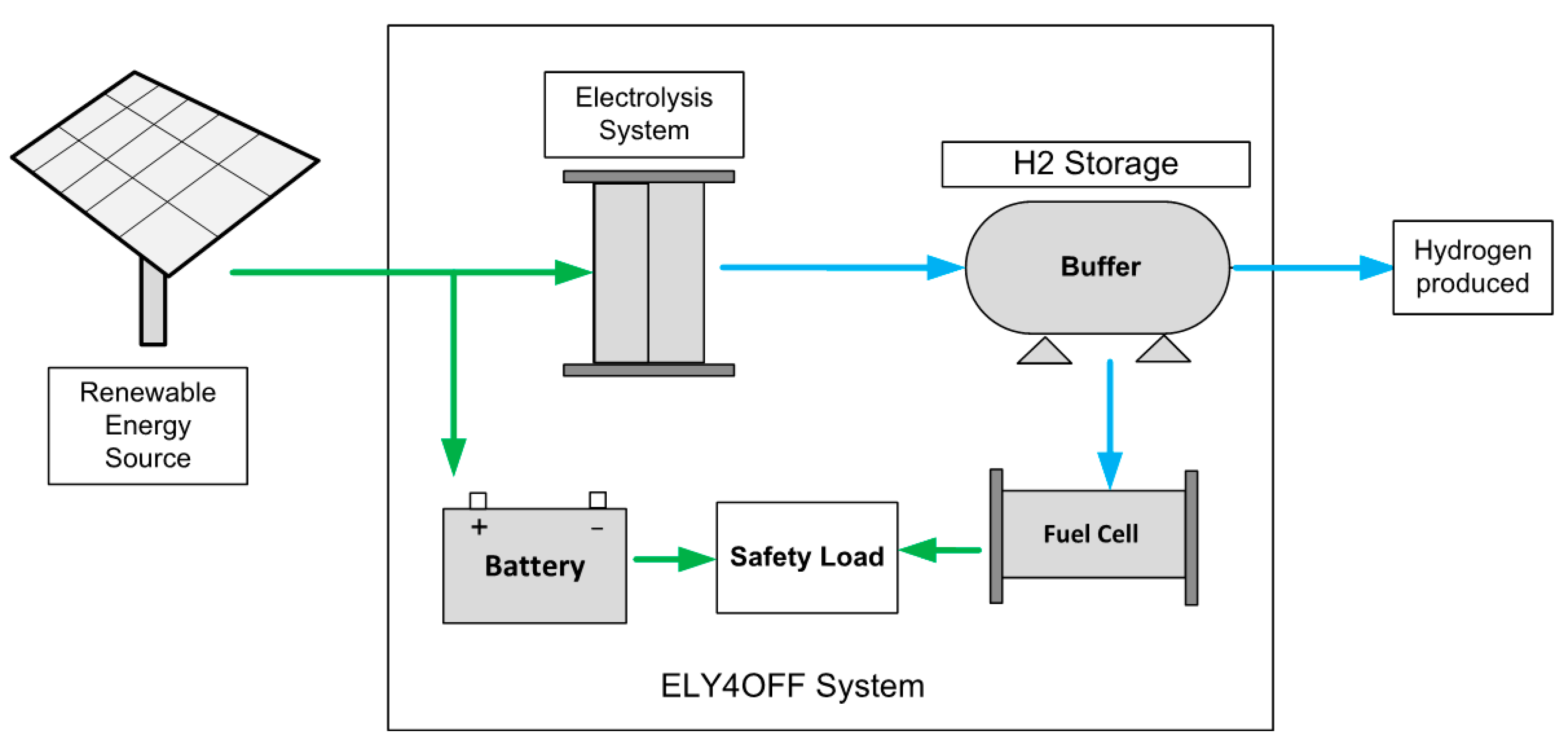
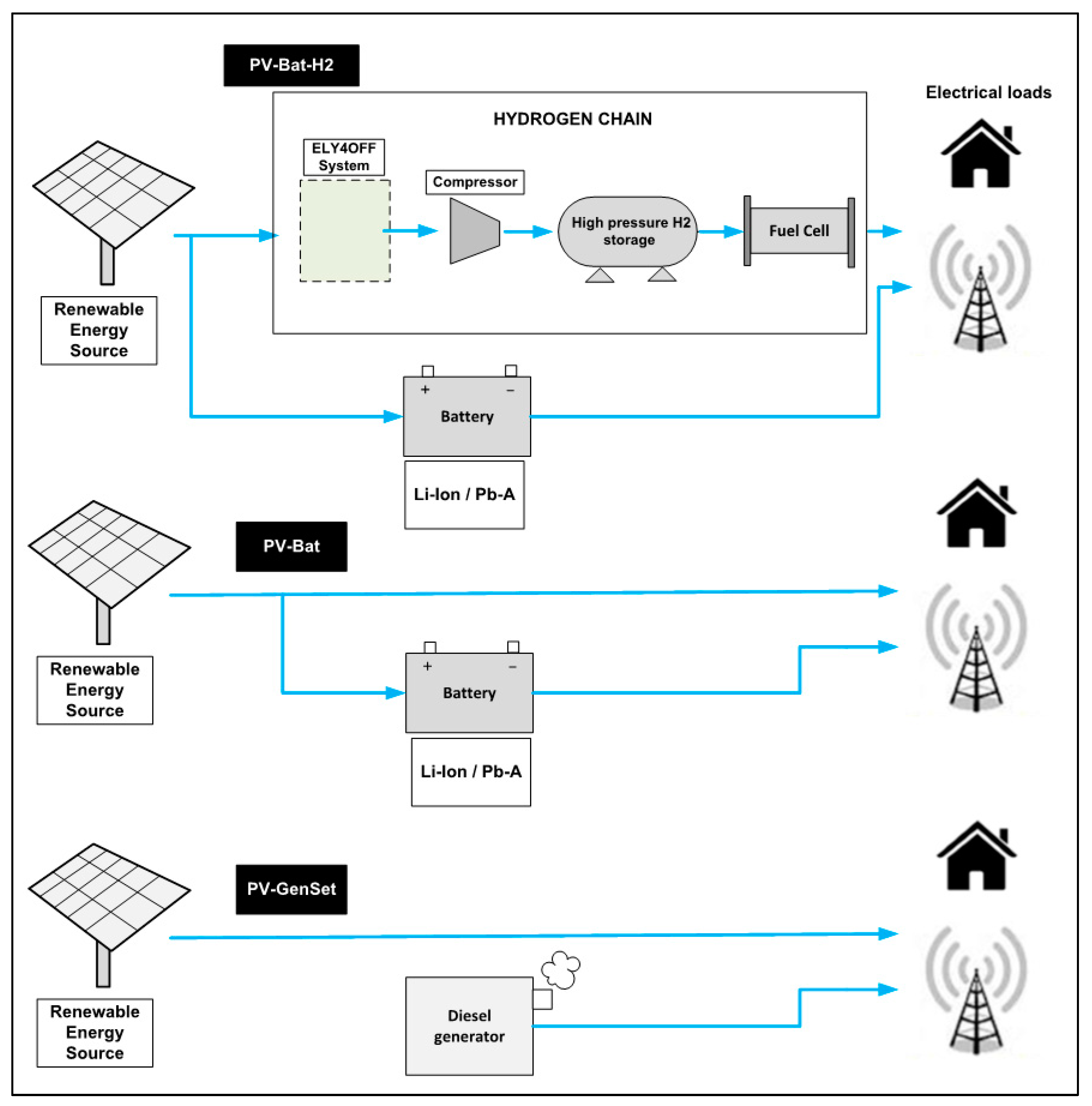
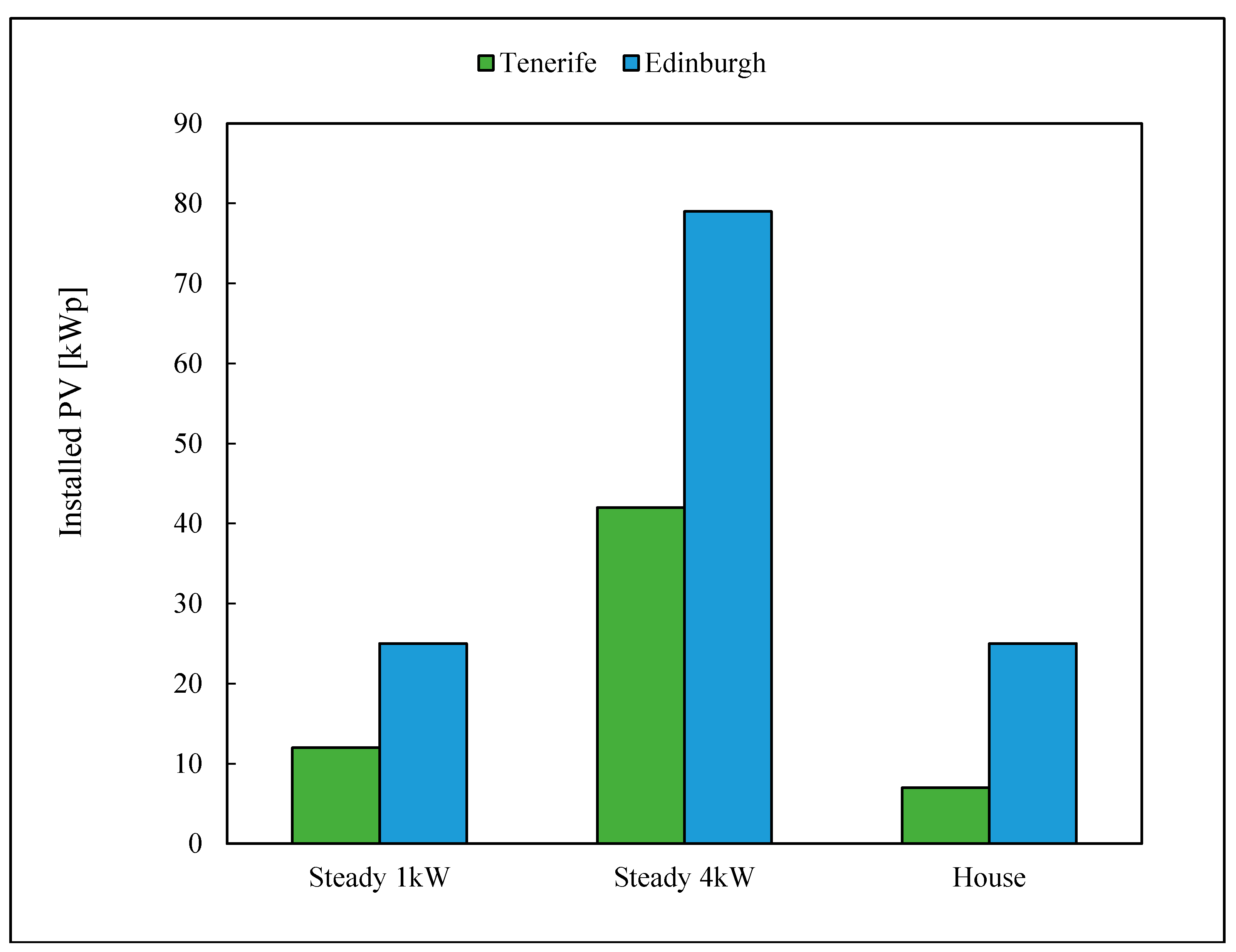
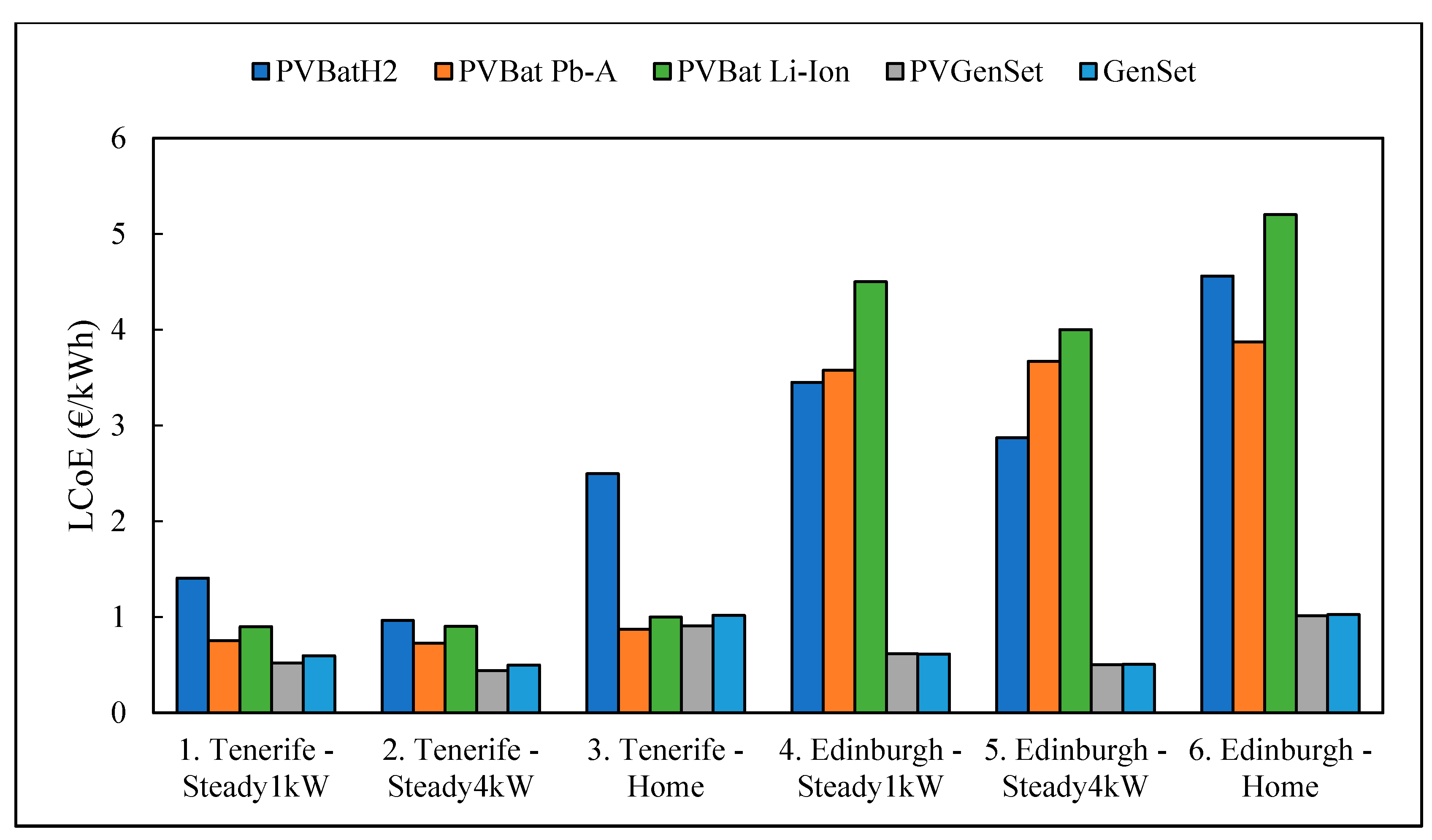
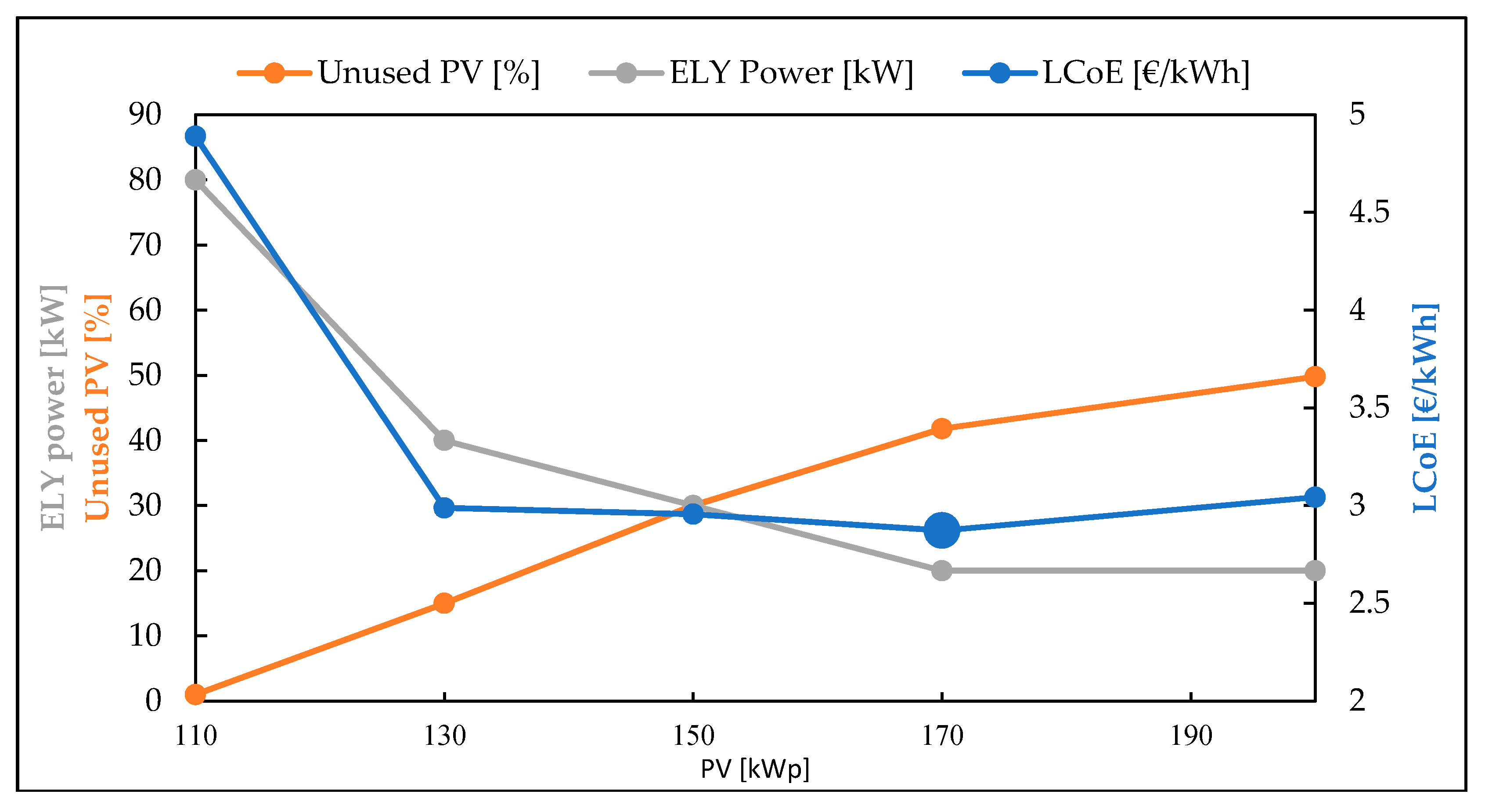

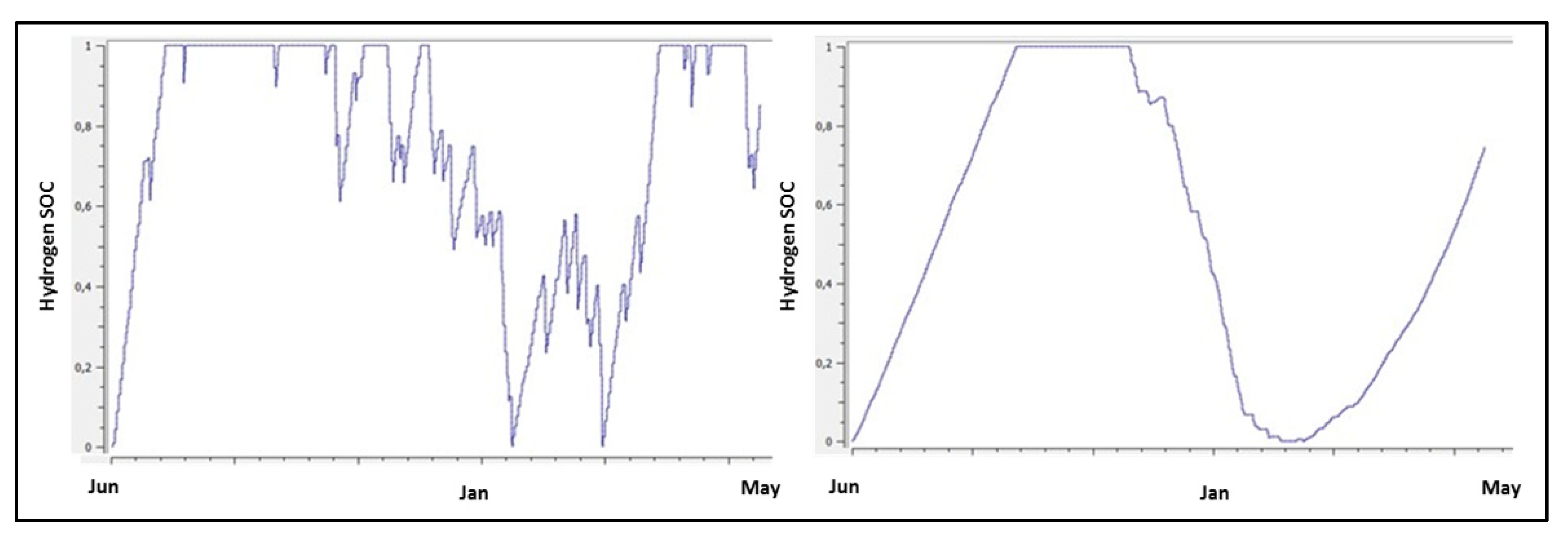
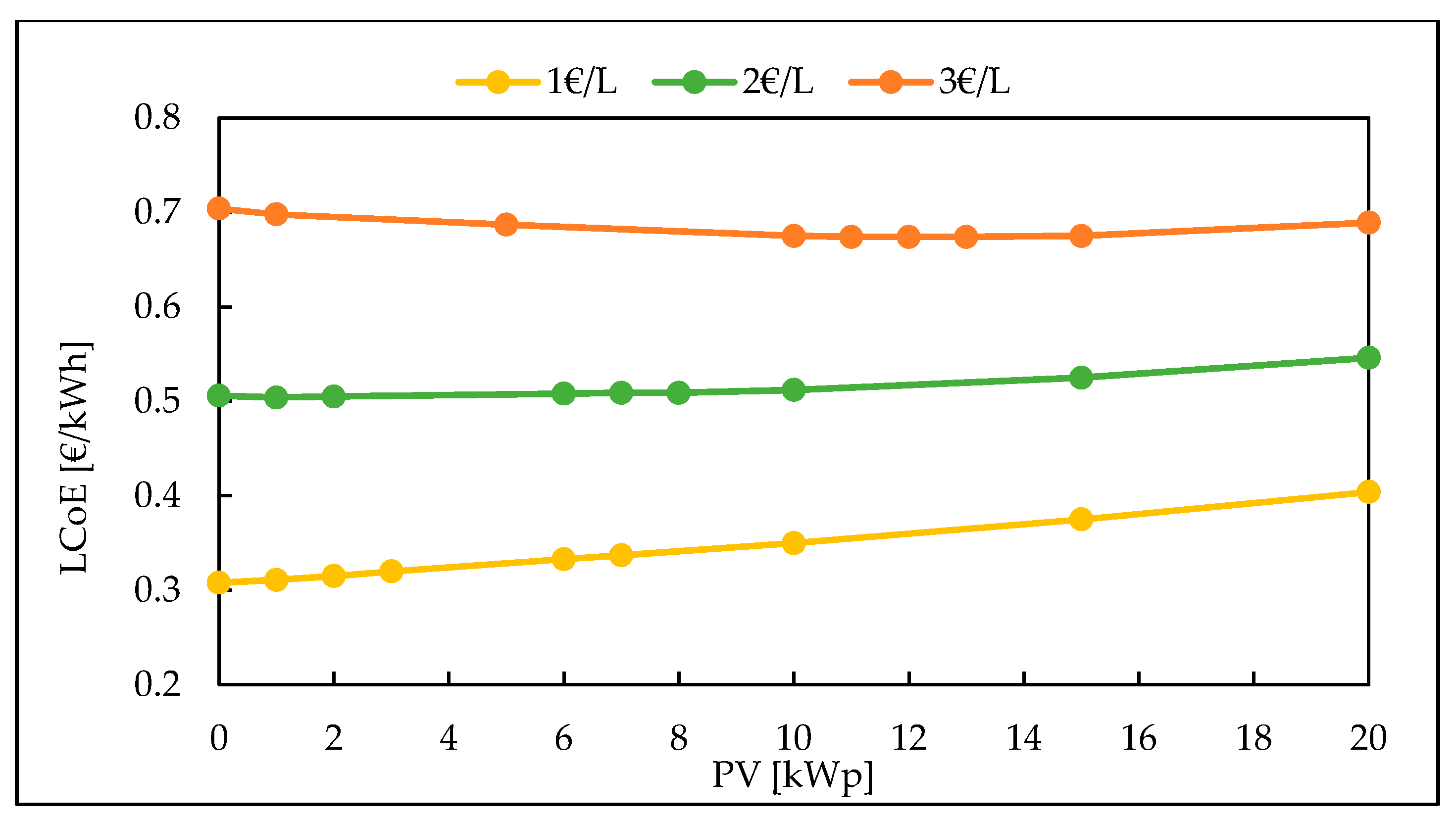
| Hypothesis | Value | Unit |
|---|---|---|
| Beginning of simulation | 1 June, year 0 | / |
| End of simulation | 31 May, year 1 | / |
| Simulation time step | 10 | Minutes |
| Economic evaluation | 20 | Years |
| Discount rate | 8 | % |
| Component replacement | Based on absolute time | Hours |
| Element | Investment | Replacement Cost | O&M (%) 1 |
|---|---|---|---|
| PV | 1670 €/kWp | 1330 €/kWp | 3 |
| DC DC converters | 0.9 €/W | 0.9 €/W | 3 |
| DC AC converter | 0.4 €/W | 0.4 €/W | 3 |
| Lead Acid batteries | 175 €/kWh | 175 €/kWh | 3 |
| Li-ion batteries | 550 €/kWh | 550 €/kWh | 0 |
| Electrolyzer | 5 €/W | 5 €/W | 3 |
| Compressor | 31 k€/kW | 31 k€/kW | 3 |
| Hydrogen storage | 353 €/kg | 353 €/kg | 3 |
| Fuel cell | 5.5 €/W | 5.5 €/W | 3 |
| Diesel generator | 420 €/kW | 420 €/kW | 0.4 €/h + 2 €/L |
| Hypothesis | Value | |
|---|---|---|
| Photovoltaic panels | Panel peak power | To be optimized with ODYSSEY (kW) |
| Solar profile locations | Tenerife/Edinburgh | |
| Azimuth | 180° (south) | |
| Tilt angle | Tenerife: 25° (optimized) Edinburgh: 41° (optimized) | |
| Module type | Standard (15% efficiency) | |
| Plant type | Fixed | |
| System losses | 14% (including dirt, reflection, conversion, thermal, wiring and orientation) | |
| Replacement time | 175,200 h (20 years) | |
| Lead-Acid Batteries | Initial SOC 1 | 0.5 |
| Minimum SOC | 0.2 (below this value, batteries cannot be discharged in order to prevent failures) | |
| Maximum SOC | 1 | |
| Storage capacity | To be optimized with ODYSSEY (kWh) | |
| Charge efficiency | 0.85 | |
| Discharge efficiency | 0.85 | |
| Min charge power | 0 W | |
| Max charge power | 1 × 106 W | |
| Min discharge power | 0 W | |
| Max discharge power | 1 × 106 W | |
| Self-discharge | 0.25%/day | |
| Replacement time | 87,600 h (10 years) | |
| Li-Ion batteries | Initial SOC | 0.5 |
| Minimum SOC | 0.2 | |
| Maximum SOC | 1 | |
| Storage capacity | To be optimized with ODYSSEY (kWh) | |
| Charge efficiency | 0.92 | |
| Discharge efficiency | 0.92 | |
| Min charge power | 0 W | |
| Max charge power | 1 × 106 W | |
| Min discharge power | 0 W | |
| Max discharge power | 1 × 106 W | |
| Self-discharge | 5%/month | |
| Replacement time | 87,600 h (10 years) | |
| Electrolyzer | Maximum operation pressure | 20 bars |
| Outlet hydrogen temperature | 40 °C | |
| Stack minimal power | 1 kW (below this value, the stack doesn’t start operation mode) | |
| Stack maximal power | To be optimized with ODYSSEY (kW) | |
| Efficiency (model polynomial efficiency) | Confidential | |
| H2O stoichiometry | 1.05 | |
| Replacement time | 175,200 h (20 years) | |
| Hydrogen Storage | Number of tanks | 1 |
| Ambient temperature | 20 °C | |
| Minimum pressure | 20 bars | |
| Initial pressure | 20 bars | |
| Maximum pressure | 350 bars | |
| Volume | To be optimized with ODYSSEY (m3) | |
| Max mass flow rate in charge | 100 kg/h | |
| Max mass flow rate in discharge | 100 kg/h | |
| Replacement time | 175,200 h (20 years) | |
| Fuel Cell | Cooling efficiency | 0.6 |
| Cooling output temperature | 20 °C | |
| Stack min power | 0.2*Max_power W | |
| Stack max power | To be optimized with ODYSSEY (W) | |
| Constant Efficiency | 48% | |
| H2 stoichiometry | 1 | |
| O2 stoichiometry | 1 | |
| Replacement time | 43,800 h (5 years) | |
| Diesel generator | Power min | 250 W |
| Power max | To be optimized with ODYSSEY (W) | |
| Constant efficiency | 28% | |
| Polynomial efficiency | Confidential | |
| Life time | 10,000 h | |
| DC DC converter | Conversion efficiency | 93% |
| Replacement time | 291,144 h (33 years) | |
| DC AC converters | Conversion efficiency | 93% |
| Replacement time | 104,700 h (12 years) | |
| Compressor 2 | Isentropic efficiency | 72% |
| Electric motor efficiency | 95% | |
| Replacement time | 87,600 h (10 years) |
| Component | Value | Range | Interval |
|---|---|---|---|
| PV panels | Peak power | [5:200] kW | 1 kW |
| Electrolyzer | Stack max power (kW) | [10:50] kW | 10 kW |
| Fuel Cell | Stack max power (kW) | [1.6:4.6] kW | 0.5 kW |
| Battery | Capacity (kWh) | [10:50] kW | 2 kW |
| Hydrogen Storage | Volume (m3) | [0.1:1] kW | 0.1 kW |
| Parameters | Boundaries |
|---|---|
| Battery technologies | Li-Ion and Lead-Acid |
| Diesel price | 1, 2 and 3 €/L |
| Customer load | 1, 4 kW loads or home load (previously defined) |
| Location | Tenerife and Edinburgh |
| Element | Value |
|---|---|
| PV installed | 130 kWp |
| Energy to provide | 35 MWh/year |
| Electrolyzer power | 50 kW |
| Capacity of the batteries | 376 kWh |
| H2 Storage | 14 m3 |
© 2018 by the authors. Licensee MDPI, Basel, Switzerland. This article is an open access article distributed under the terms and conditions of the Creative Commons Attribution (CC BY) license (http://creativecommons.org/licenses/by/4.0/).
Share and Cite
Gracia, L.; Casero, P.; Bourasseau, C.; Chabert, A. Use of Hydrogen in Off-Grid Locations, a Techno-Economic Assessment. Energies 2018, 11, 3141. https://doi.org/10.3390/en11113141
Gracia L, Casero P, Bourasseau C, Chabert A. Use of Hydrogen in Off-Grid Locations, a Techno-Economic Assessment. Energies. 2018; 11(11):3141. https://doi.org/10.3390/en11113141
Chicago/Turabian StyleGracia, Lorién, Pedro Casero, Cyril Bourasseau, and Alexandre Chabert. 2018. "Use of Hydrogen in Off-Grid Locations, a Techno-Economic Assessment" Energies 11, no. 11: 3141. https://doi.org/10.3390/en11113141
APA StyleGracia, L., Casero, P., Bourasseau, C., & Chabert, A. (2018). Use of Hydrogen in Off-Grid Locations, a Techno-Economic Assessment. Energies, 11(11), 3141. https://doi.org/10.3390/en11113141





